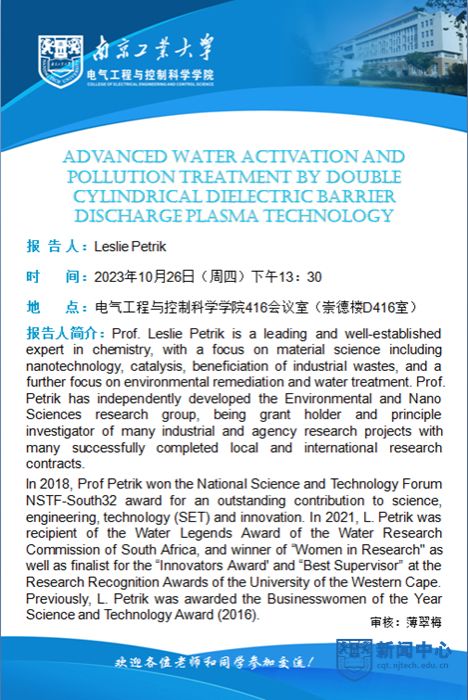學術活動 NAVIGATION
Advanced Water Activation and Pollution Treatment by Double Cylindrical Dielectric Barrier Discharge Plasma Technology
報告題目:Advanced Water Activation and Pollution Treatment by Double Cylindrical Dielectric Barrier Discharge Plasma Technology
報告人:Leslie Petrik
報告人單位:University of the Western Cape (UWC), South Africa
報告時間:2023年10月26日13: 30
會議地點:電氣工程與控制科學學院416會議室(崇德樓D座416)
舉辦單位:電氣工程與控制科學學院
報告人簡介:Prof. Leslie Petrik is a leading and well-established expert in chemistry, with a focus on material science including nanotechnology, catalysis, beneficiation of industrial wastes, and a further focus on environmental remediation and water treatment. Since 2003, L. Petrik has independently developed the Environmental and Nano Sciences research group, in the Department of Chemistry at the University of the Western Cape, being grant holder and principle investigator of many industrial and agency research projects with many successfully completed local and international research contracts
Prof Petrik has supervised to completion and graduated 38 PhD, 66 MSc students, and hosted 27 Post-doctoral fellows. She is Principle investigator of many completed and ongoing industrial and agency research projects. Prof Petrik has acted as examiner for 19 PhD Theses and for42 MSc/MEng theses. Overall, her publications include 5 granted patents; 11 book chapters; 213 journal publications; 317 presentations.
ln 2018, Prof Petrik won the National Science and Technology Forum NSTF-South32 award for an outstanding contribution to science, engineering, technology (SET) and innovation. In 2021, L. Petrik was recipient of the Water Legends Award of the Water Research Commission of South Africa. and winner of “Women in Research" as well as finalist for the “Innovators Award' and “Best Supervisor” at the Research Recognition Awards of the University of the Western Cape. Previously, L. Petrik was awarded the Businesswomen of the Year Science and Technology Award (2016) and was the winner of Water Research Commission Research Award for Transformation and Redress (2015).
報告摘要:The occurrence of poisonous substances in water streams mainly originates from numerous domestic, agricultural, and industrial sources that are contaminated with chemicals, prescription medication, cleaning and disinfecting products, cosmetics, stabilizers, artificial fertilizers, pesticides, fuels, and dyes among others. The contaminants possess carcinogenic, mutagenic, and teratogenic properties and are difficult to degrade in a natural environment. Recently double cylindrical dielectric barrier discharge (DCDBD) plasma technology developed at the Environmental and Nano Sciences Group at the University of the Western Cape in South Africa has demonstrated great efficiency to oxidize and mineralize these poisonous substances.Our investigations have demonstrated that DCDBD, either alone or in combination with catalysts, represents a highly effective and advanced technology for the purification of waste and wastewater. However, its scale up process from lab to industrial level may be challenging.
審核人:薄翠梅




